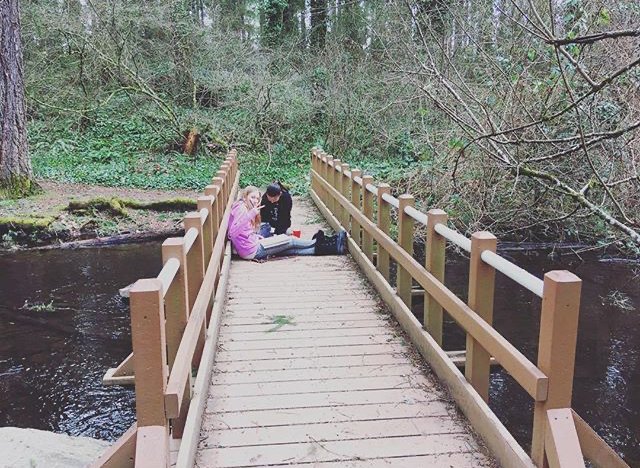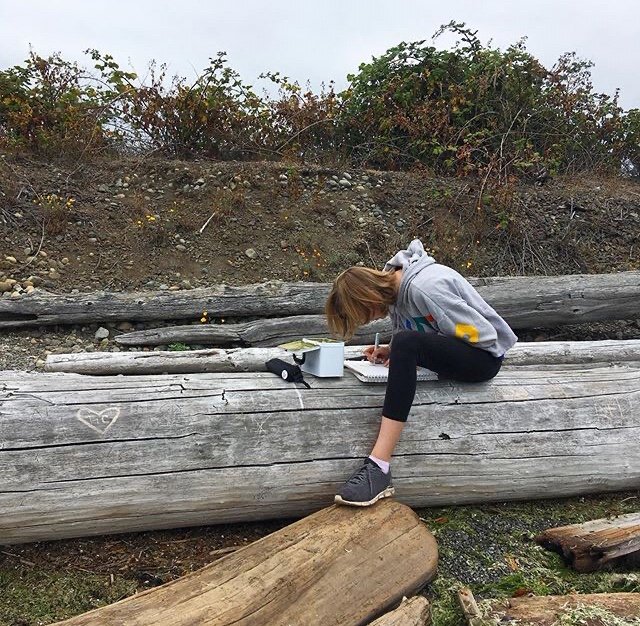How to Teach Nature Journaling
MANAGING THE OUTDOOR CLASSROOM
Journaling activities take concentration and focus. We want to set students up for success by taking care of their basic needs and journaling at a time when they’ll be engaged.
Meeting Students’ Physical Needs
Journaling (and outdoor learning in general) is not about “toughing it out” in the elements to build character. Students’ basic needs are important, and if those needs are not taken care of, students’ attention will be on them rather than on journaling. To tend to students’ physical needs outside, we:
Pay attention to weather conditions and adjust our plans accordingly. Children are more susceptible than adults to the effects of temperature. If it is excessively hot, cold, wet, or windy, students will be less capable of focusing on journaling activities, and we adjust our location and plan to support their physical comfort.
Invite students to wear clothing that is comfortable for them, and make sure they know about outings ahead of time. If getting their clothes or shoes dirty on outings is a serious concern for students, we collect low-cost boots and clothes from thrift stores that they can borrow for field trips to areas with muddy or wet conditions.
Wear a hat and face the sun while we are giving directions, so that students don’t have to look into the sun.
Carry low-cost materials to mitigate the effects of weather, such as squares of plastic from thick garbage bags or a similar material for students to sit on. These are particularly useful in wet conditions or if students are worried about getting dirty or sitting on the ground. (In colder conditions, we use squares cut from a cheap foam camping pad to insulate students from the ground. Without it, they will lose heat quickly.)
Encourage students to bring hats, or bring a class set of inexpensive foam-rimmed visors or hats to help shield them from the sun so that they can see their journal page.
Carry a small spray bottle to mist students’ faces and necks during hotter seasons. This works wonders for their endurance in hot weather. (Spray bottles are also great for misting spider webs, making them more visible to the eye).
Supporting Students Emotionally
Tending to students’ emotional needs helps them learn outdoors. Each of our students will have a different relationship to nature, informed by their prior experiences and cultural perspectives. We try not to assume any level of comfort or discomfort in our students. Instead, we meet them with curiosity and ask about their previous experiences, their feelings about being outside, and what we can do as a leader to make them comfortable. As we choose outdoor locations and prepare for outings, we then take the individual experiences of our students into account.
Before you take your class outside, share how you’ll take care of their physical needs, and be clear about what students should expect in the outdoor experience—how long they will be there and whether there will be access to a bathroom (and, if there will not be a bathroom accessible, telling them how to go outside). When students are new to outdoor learning, we find it is better to visit one place several times rather than switching locations every outing. Returning to a place allows students to get familiar and comfortable, leading them to focus more and more on learning instead of navigating a new location. These practices go a long way. Tending to students’ needs and establishing routines can help them feel safe and know what to expect, allowing them to focus on journaling and their learning experience.
Setting Expectations
It’s important on the first outing as a group to establish the outdoors as a learning space. We communicate that the rules of the classroom or the agreements of the program still apply, and we offer any additional expectations for the new context. When we are firm yet kind in setting boundaries and establishing structure, we support students’ sense of safety and act as reliable leaders. Yet we don’t structure every moment of this first excursion. There is a lot going on outdoors. If all of students’ time outside is directed by the teacher, they may become distracted from the learning experience because they never get the chance to explore and check out what is interesting to them. The routine I Notice, I Wonder, It Reminds Me Of (otherwise known as INIWIRMO) is an ideal tone-setting activity and a way to establish the outdoors as a learning space right away. It’s the first thing we do with any group we work with in the outdoors. It is simple and offers students tools for exploring nature that they can continue to employ throughout the rest of the program. It also offers students a framework for gathering information that can apply directly to their journaling. INIWIRMO begins with structure and focused learning, then offers students the autonomy and choice to explore whatever they find interesting, using the framework of the routine to guide them. Offering this autonomy to students can lead to increased buy-in to learning experiences.
Defining Roles and Responsibilities
Inviting students to take on roles and responsibilities that help you manage the outdoor classroom engages them as active participants for preparing for excursions. For example, one student can be in charge of handing out journals, another of making sure the group drinks water, another of noting the time the group begins and ends journaling, another of recording the moment with a photograph, and so on. Invite individual students to choose a permanent role that they are excited to take on, or rotate jobs and roles. Having a role or job can also engage extra-energetic students. The responsibility focuses their energy in a positive way, gives them a role they are appreciated for, and honors the assets they bring to a group experience.
Using Routines and Rituals
Regular routines and rituals can support students’ engagement and focus while nature journaling.To help students drop in to the journaling process, we sometimes develop a short ritual for opening and closing a journaling or outdoor experience. An opening ritual can be as simple as taking a few breaths together, making a group coyote howl, or walking between two trees as a symbol of a “gateway” to exploration. Closing rituals might include a circle of gratitude sharing, laying out journal pages and checking out one anothers’ work, or a moment for students to share something with the group that they want to remember about their experience. Rituals like these set an attentive tone and provide a routine that marks the mindset students get into when they journal.
Deciding When to Journal
Many student management challenges can be avoided by planning when journaling experiences will take place and making adjustments in the moment when necessary. When we journal with students, we:
Choose a time of day when we know our group of students are likely to be able to focus. (For example, if our students are consistently wired right before lunch, we’ll plan to journal at another time.)
Avoid doing several journaling activities in a row. Journaling is hard work, and we want to recognize that students may burn out if we push them too hard.
Intersperse focused journal activities with walking, discussion, classroom work, or other nature exploration.
Don’t force it. If a group has a lot of energy when we’ve planned to do a journaling activity, we come up with a quick way for students to move around instead—move up a hill, pretend to be squirrels, offer free time, or play a short, high-energy game. Afterward, we check in to see if students are ready to slow down and focus.






